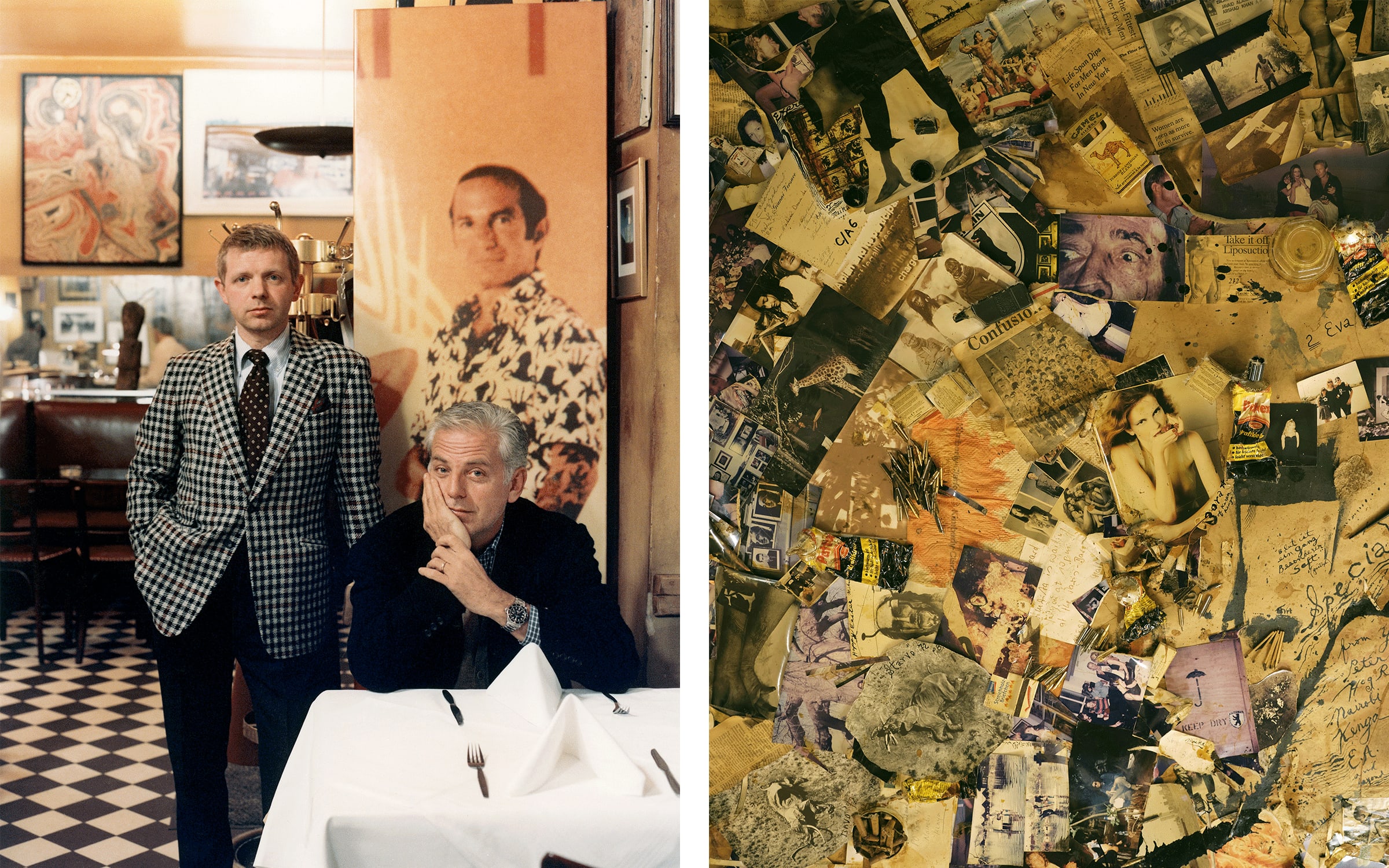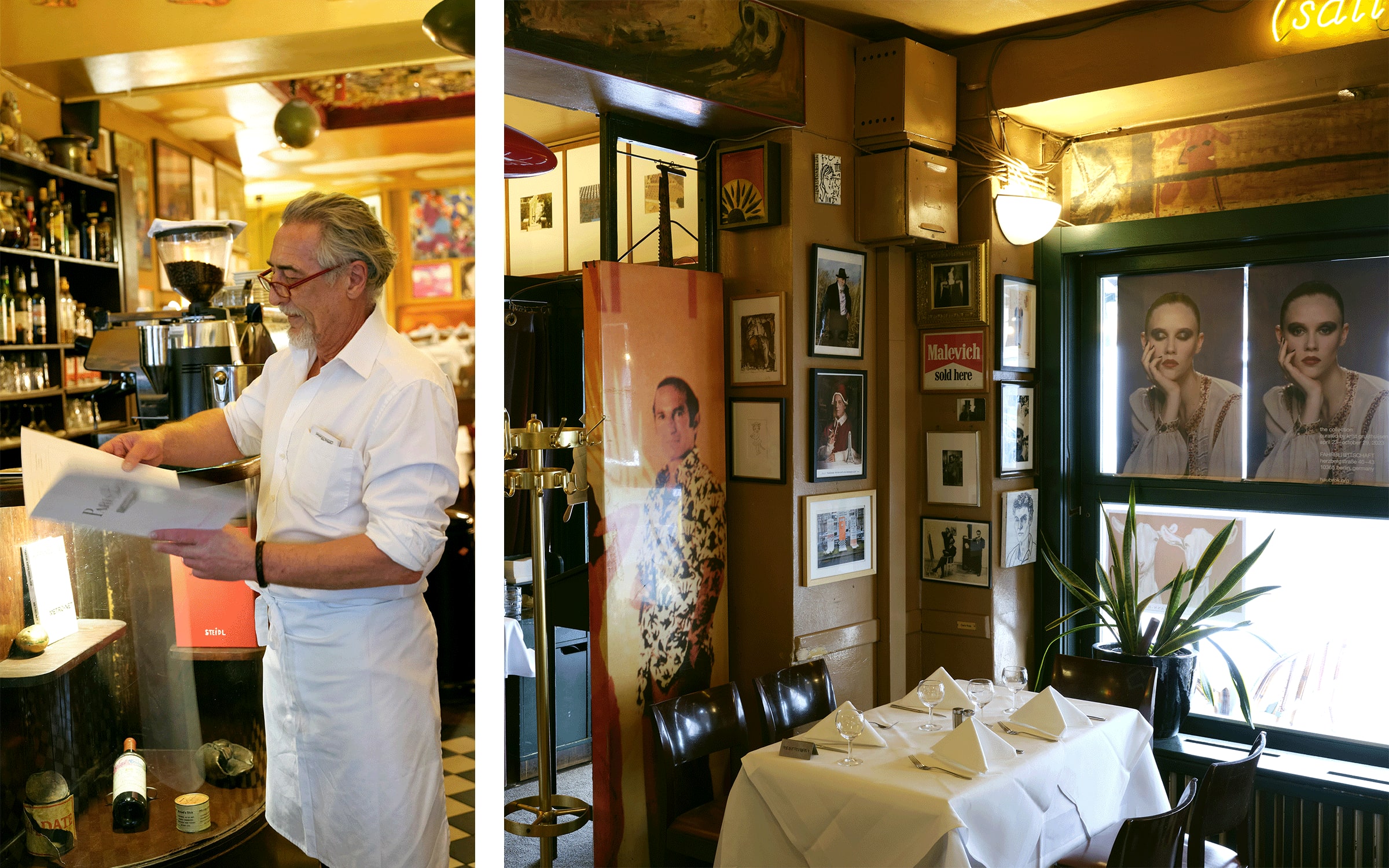
German playwright Heiner Müller once dubbed Paris Bar the ‘hell of Berlin bars.’ Müller lived in the Communist East, but had documents that allowed him to pass between East and West when the Berlin Wall still divided the city. In the 1980s, he was a regular at Kantstrasse 152.
Then as now, Paris Bar felt like a well-kept time capsule: tightly packed tables framed by bistro chairs and red leather benches; a buzz of voices speaking many languages; dimmed lighting; starched tablecloths; and gracious, white-aproned waiters who try to score you a table even when the place is full. And of course, the yellowed walls are packed with hundreds of works of art.

Müller was less interested in Paris Bar’s French cuisine than in Glenmorangie whiskey and Montecristo No. 1 cigars. In a city with no closing time or last call, Müller understood Berlin’s nocturnal lawlessness. In 1991, he decreed: ‘Anyone who enters here abandons all hope of escape before morning, and of coming out the same as he went in.’ The poet often stayed until dawn, ‘when the pictures on the walls of the Paris Bar begin to speak.’ Talking pictures? ‘Heiner Müller was a good listener,’ explains the designer Grischa Meyer, who often accompanied Müller on his West Berlin benders in the late 1980s.
But Müller’s ‘hell’ was and is only one side of the Paris Bar. The place is also heavenly, in its own way. How else to explain that Otto Sander, the actor who played the angel Cassiel in Wim Wenders’s 1980s classic film Wings of Desire, was also a regular here? To this day, an inconspicuous brass plate on the counter engraved with Sander’s name marks the seat once reserved for him. Star filmmakers like Volker Schlöndorff and Margarethe von Trotta often stopped by in the 1980s. And Rainer Werner Fassbinder, who shot his last film Querelle in Berlin in 1982, always turned up with an entourage, often around 25 people. It was like a ‘film within a film,’ Michel Würthle, Paris Bar’s longtime owner, manager, and impeccable host once said in an interview (Würthle passed away in March at the age of 79). ‘There was a lot going on on those evenings.’ This hasn’t changed – cinephiles, gallerists, artists, and collectors still throng the place.
Paris Bar was founded in 1950 when Jean Coupy, a former canteen cook in the occupying French army, opened the bar on Kantstrasse. Affordable French onion soup, minute steak, and French table wine were on the menu at the time. In the early years, Paris Bar was frequented by students from the nearby art academy, who later became loyal customers as full-fledged artists. In 1979, Würthle and Reinald Nohal finally took over the outdated bistro and carefully modernized it, polishing its patina. They had received a tip-off from local lawyer Otto Schily (who later became the German Federal Minister of the Interior) that the place was available to rent. Würthle and Nohal, both Austrian artists associated with the Viennese Actionist scene, were already experienced hosts through Exil, the legendary artists’ bar across town which Würthle ran alongside Ingrid and Oswald Wiener with Nohal as chef.
In the wild eighties, Paris Bar truly became the cultural heart of Berlin – a bohemian living room of sorts – when West Berlin was a Cold War island and a magnet for artists, dropouts, anarchists, and even visiting visionaries like David Bowie and Iggy Pop. In the mid-2000s, it briefly experienced economic difficulties and later changed owners in the background. The new operators were prudent enough to let Würthle – whose dandyism and Viennese humor combined to form an irresistible mixture – continue to represent the bistro to the outside world. This ensured continuity.

Müller and Sander’s favorite order was boudin noir – French black pudding – with potato salad. They allegedly shared this preference with Martin Kippenberger, who came to define Paris Bar in the late 1970s and early 1980s – and still does. Within walking distance of the art academy, the Schaubühne theater, and the legendary Rudolf Springer gallery, artists frequented Paris Bar from the beginning. Painters Georg Baselitz, Markus Lüpertz, Jörg Immendorff, and Sigmar Polke all spent debauched nights here. But only Kippenberger, who died in 1997 at only 44, managed to make the restaurant on Kantstrasse part of his personal mythology. In no museum does Kippenberger’s Street Lamp for Drunks (1988) look as good as it does here. Its red lightbulb lights the way for passersby and guests alike.
Kippenberger found a soulmate in Würthle, and the Paris Bar was his ‘home port,’ as Kippenberger’s sister and biographer Susanne puts it. ‘When Martin was in Berlin,’ she says, ‘he was there almost all day – morning, noon, and of course night – even when he slept at the Kempinski around the corner. He didn’t even have breakfast in the hotel. As soon as he got up, he went to the bar, sat down with the staff who used to eat at half past ten, and talked and joked with them; he drew, thought, and let them tell him their stories.’
In 1979, Kippenberger gave Würthle his series of around 70 paintings ‘Uni di voi, un tedesco in Firenze’ [One of You, A German in Florence] (1976–77). The small-format canvases, which show snapshot-like views of Florence, are painted in gray, black, and white. Würthle returned the favor by giving the artist free meals for life (for himself and a plus-one). Kippenberger’s pictures of Florence hung in the restaurant for a long time, later landing in the collection of German collector Friedrich Christian ‘Mick’ Flick.
‘Then as now, the art in Paris Bar never seems foreign, but always, or almost always, as part of a lived whole,’ said Bruno Brunnet, co-owner of Contemporary Fine Arts gallery. Walls and corners are covered with paintings, drawings, photographs, installations, and sculptures. Würthle never wanted the place to be understood as an art exhibition: ‘You don’t want to make the guest happy with the pictures, but rather yourself,’ he said. Some artworks are on permanent loan, others purchased by Würthle, still others were gifted to him. The salon hang is sometimes rearranged; guests are always surrounded by recent (sometimes very recent) art history.

On the wall – among many other artworks – is a spring-mounted forearm sculpture by Sarah Lucas; Juergen Teller’s giant Yves Saint Laurent portrait; a grim-looking self-portrait by Dash Snow; a Larry Clark print; Truman Capote painted by Peter Doig; and one of Valie Export’s famed ‘Action Pants: Genital Panic’ posters from 1969. There’s a large-scale Daniel Richter painting, which reimagines the famous Kippenberger canvas Paris Bar (1991) that once hung in the same place. Some pieces are even installed on the ceiling, including Cosima von Bonin’s red-and-white rocket with ‘Miss Riley’ lettering. The list is endless.
Art here is never just decoration, but a core part of the atmosphere, which always includes provocation. For a while, people ate steak frites under the dead eyes of Damien Hirst’s pickled half-rotten cow skull. The fact that some of the works are extremely valuable is part of the concept. ‘I love some of the pictures,’ Würthle said in the early 1980s. ‘My dream would be if there were hidden treasures hanging there, uninsured, just hanging on a nail … like pearls before the swine, with me as the main sow.’ To a certain degree, this thought experiment later became reality. In 2009, Kippenberger’s Paris Bar, which had graced the rear wall on the right side of the restaurant for more than a decade, fetched a whopping GBP 2.3 million at a Christie’s auction. Word on the street is that now, after Würthle’s passing, Paris Bar will carry on, but how this will look in practice, without its eccentric host, remains to be seen.

When the painter Xenia Hausner came to Berlin in the 1980s, the place was a microcosm of West Berlin: ‘Life in the city gathered there,’ she says. Even if reunified Berlin is a different city, Hausner still goes to the Paris Bar. She was always fascinated by the curved sign on the facade. When she found out it had a twin, she borrowed it to memorialize in a painting. In her Paris Bar (2002), two figures meet for a canapé under the red and green neon light. They appear strangely absorbed, as if in a dream sequence in the middle of a Berlin drama, long after midnight. A familiar scene to many; may the dream never end.
The 19th Gallery Weekend Berlin takes place from April 28 to 30, 2023.
Kito Nedo is a journalist and art critic for Süddeutsche Zeitung and Frieze magazine. He lives in Berlin and Basel.



Leave a Reply